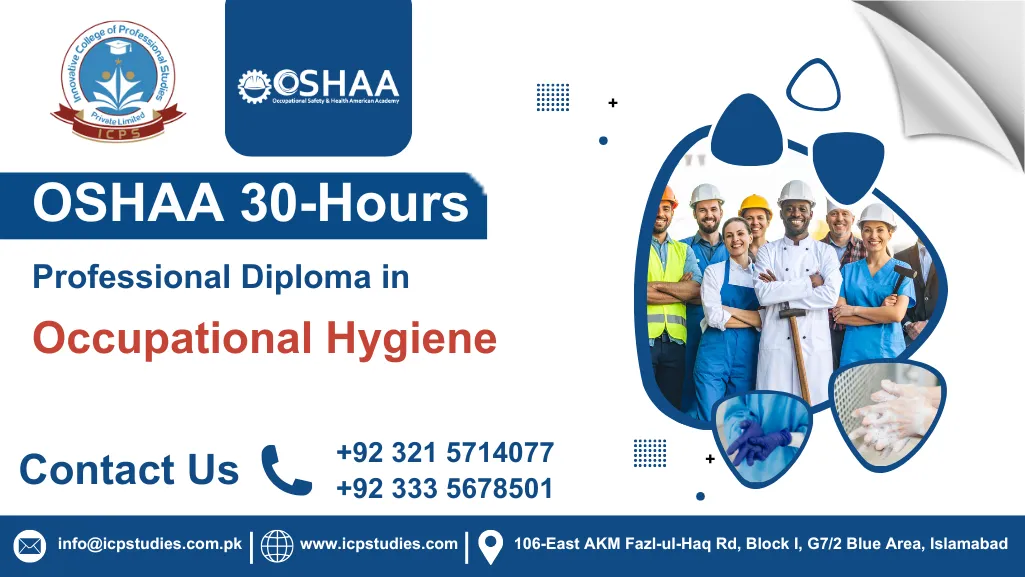The OSHAA 30-Hours Professional Diploma in Occupational Hygiene is a specialized training program designed to provide learners with a comprehensive understanding of workplace health hazards and the strategies required to manage them effectively. Occupational hygiene plays a critical role in protecting workers from risks such as chemical exposure, noise, dust, biological agents, and poor ergonomic practices. This diploma introduces participants to the principles of hazard identification, risk assessment, and control measures, ensuring they gain both theoretical knowledge and practical skills to promote safer working environments. By focusing on evidence-based practices, the program empowers learners to contribute meaningfully to workplace safety and employee wellbeing.
Structured across 30 hours of intensive study, the OSHAA 30-Hours Professional Diploma in Occupational Hygiene is divided into seven carefully designed units that blend scientific knowledge with practical applications. Learners will explore topics such as workplace monitoring, exposure assessment, ventilation systems, personal protective equipment, and health surveillance. Case studies and real-world examples are integrated throughout the curriculum to highlight how occupational hygiene principles are applied across industries including manufacturing, construction, healthcare, and agriculture. This approach ensures that learners not only understand the science behind occupational hygiene but also develop the ability to apply it in diverse professional contexts.
Upon successful completion, learners will be awarded the OSHAA 30-Hours Professional Diploma in Occupational Hygiene, a professional certification that demonstrates their commitment to advancing workplace health and safety standards. This diploma can serve as a pathway to further certifications and diplomas in areas such as industrial hygiene, environmental health, occupational safety management, and risk assessment. With workplace health increasingly recognized as a cornerstone of organizational success, this program equips participants with the expertise to safeguard employees, enhance compliance, and strengthen the overall integrity of occupational health systems.
All About OSHAA 30-Hours Professional Diploma in Occupational Hygiene
Course Overview
The OSHAA 30-Hours Professional Diploma in Occupational Hygiene is designed to provide learners with a comprehensive understanding of workplace health hazards and the methods used to control them. Occupational hygiene is a vital discipline that focuses on anticipating, recognizing, evaluating, and controlling environmental factors that may affect workers’ health and wellbeing. This diploma introduces participants to the principles of hazard identification, risk assessment, and preventive strategies, ensuring they gain both theoretical knowledge and practical skills to promote safer working environments.
The program is structured into 8 units delivered over 30 hours of training, each carefully developed to balance scientific knowledge with practical application. Learners will explore a wide range of topics including chemical hazards, biological risks, noise and vibration, ergonomics, ventilation systems, and personal protective equipment. Case studies and real-world examples are integrated throughout the curriculum to demonstrate how occupational hygiene principles are applied across industries such as manufacturing, construction, healthcare, and agriculture. This approach ensures learners can connect theory to practice and apply their knowledge in diverse professional contexts.
The 30 hours of training are intensive yet flexible, making the diploma accessible to learners from different educational and professional backgrounds. Interactive learning methods, scenario-based exercises, and applied assessments help reinforce knowledge while building confidence in applying occupational hygiene practices. Whether participants are new to workplace safety or experienced professionals seeking to expand their expertise, the program provides valuable insights into managing health risks and improving workplace conditions.
Upon successful completion, learners will be awarded the OSHAA 30-Hours Professional Diploma in Occupational Hygiene, a professional certification that highlights their commitment to advancing workplace health and safety standards. This diploma can serve as a pathway to further certifications and diplomas in areas such as industrial hygiene, environmental health, occupational safety management, and risk assessment. With workplace health increasingly recognized as a cornerstone of organizational success, this program equips participants with the expertise to safeguard employees, enhance compliance, and strengthen occupational health systems.
To enroll in the OSHAA 30-Hours Professional Diploma in Occupational Hygiene, learners are expected to meet the following criteria:
- Age requirement: Applicants should be at least 18 years old to ensure maturity and readiness for professional-level study.
- Educational background: A basic level of secondary education is recommended, though no prior specialization in occupational hygiene is required.
- Language proficiency: Learners must have a good command of English, as all course materials, case studies, and assessments are delivered in English.
- Work experience: Previous experience in workplace safety, health, or related fields is beneficial but not mandatory, as the course is designed to accommodate both beginners and professionals.
This diploma is accessible to a wide range of learners, making it an excellent opportunity for anyone passionate about workplace health, safety, and hygiene. By meeting these entry requirements, participants can confidently begin their journey toward earning a professional certification that enhances their skills and career prospects in occupational health and safety.
The ideal learner for this diploma is someone who is committed to improving workplace health standards, motivated to understand occupational hazards, and eager to apply practical solutions that protect workers and organizations. This program is designed for individuals who want to build expertise in occupational hygiene and contribute meaningfully to safer work environments.
Personal Attributes
- Strong interest in workplace health and safety
- Commitment to ethical practices and employee wellbeing
- Analytical mindset with attention to detail
- Motivation to learn and apply knowledge in real-world contexts
- Ability to think critically about risks and preventive measures
Educational Background
- Basic secondary education or equivalent level of study
- Willingness to engage with scientific and technical concepts
- Comfort with reading and interpreting occupational health materials
- Openness to learning about regulatory frameworks and compliance
- Desire to expand knowledge without requiring prior specialization
Professional Aspirations
- Interest in pursuing roles in occupational health, safety, or hygiene management
- Desire to strengthen credibility with a professional certification
- Ambition to contribute to workplace safety initiatives across industries
- Willingness to explore opportunities in auditing, compliance, or consultancy
- Enthusiasm for continuous learning and further certifications in occupational safety
Learning Style
- Preference for structured modules with practical applications
- Ability to engage with case studies and scenario-based exercises
- Comfort with interactive and applied learning approaches
- Willingness to balance self-paced study with guided training
- Appreciation for evidence-based practices and real-world examples
Work Experience and Skills
- Prior exposure to workplace safety or health roles is beneficial but not essential
- Strong communication and problem-solving skills
- Ability to collaborate with teams and stakeholders in occupational health contexts
- Confidence in applying knowledge to professional environments
- Organizational skills to manage study time effectively
Commitment to Outcomes
- Dedication to completing 30 hours of structured training
- Willingness to integrate learning into professional practice
- Desire to earn a recognized professional diploma in occupational hygiene
- Readiness to pursue further certifications and diplomas in related fields
- Commitment to making a meaningful contribution to workplace health and safety
Ending Statement
The ideal learner is someone who combines curiosity, dedication, and a genuine passion for protecting workers from occupational hazards. By enrolling in this diploma, participants gain valuable knowledge, practical skills, and a professional certification that enhances both personal growth and career opportunities in occupational hygiene and workplace safety.
Study Units
- Introduction to Occupational Hygiene (3 Hours)
- Chemical Hazards and Exposure Control (4 Hours)
- Physical and Biological Hazards in the Workplace (4 Hours)
- Workplace Risk Assessment and Exposure Monitoring (4 Hours)
- Ventilation and Respiratory Protection (3 Hours)
- Personal Protective Equipment (PPE) and Workplace Controls (4 Hours)
- Workplace Ergonomics and Human Factors (4 Hours)
- Legal and Regulatory Framework in Occupational Hygiene (4 Hours)
Learning Outcomes
By completing the OSHAA 30-Hours Professional Diploma in Occupational Hygiene, learners will gain a comprehensive understanding of workplace hazards, risk management strategies, and the principles of occupational hygiene. The following outcomes highlight the knowledge and skills participants will develop across each unit of study.
Introduction to Occupational Hygiene
- Understand the principles and importance of occupational hygiene in workplace safety
- Identify key workplace hazards and their impact on employee health and wellbeing
- Recognise the role of occupational hygienists in risk prevention and management
- Explore how occupational hygiene contributes to regulatory compliance and organizational success
- Appreciate the link between occupational hygiene and long-term worker productivity
Chemical Hazards and Exposure Control
- Identify common hazardous substances in the workplace and their potential health effects
- Understand methods for assessing chemical exposure, including monitoring techniques
- Learn strategies for controlling chemical hazards such as substitution, ventilation, and safe handling practices
- Explore the importance of chemical safety data sheets and hazard communication systems
- Recognise the role of training and awareness in reducing chemical exposure risks
Physical and Biological Hazards in the Workplace
- Recognise physical hazards including noise, vibration, radiation, and temperature extremes
- Understand biological risks such as bacteria, viruses, and fungi in occupational settings
- Learn control measures to minimise exposure to physical and biological hazards
- Explore workplace policies and procedures for managing biological risks
- Appreciate the importance of monitoring and reporting incidents related to physical and biological hazards
Workplace Risk Assessment and Exposure Monitoring
- Conduct risk assessments to identify and evaluate workplace hazards
- Understand exposure monitoring techniques for chemical, physical, and biological agents
- Learn how to interpret monitoring data and implement corrective actions
- Explore the role of continuous monitoring in maintaining workplace safety standards
- Recognise how risk assessment supports proactive hazard management
Ventilation and Respiratory Protection
- Understand the role of ventilation in controlling airborne contaminants
- Learn about different types of ventilation systems and their effectiveness
- Identify appropriate respiratory protection equipment and understand its proper use
- Explore maintenance and inspection requirements for respiratory protection systems
- Recognise the importance of combining ventilation with PPE for effective hazard control
Personal Protective Equipment (PPE) and Workplace Controls
- Understand the selection, use, and maintenance of PPE for various workplace hazards
- Learn about engineering and administrative controls to reduce exposure risks
- Recognise the limitations of PPE and the importance of comprehensive hazard management strategies
- Explore training requirements for effective PPE usage in the workplace
- Appreciate the role of workplace culture in ensuring compliance with PPE standards
Workplace Ergonomics and Human Factors
- Identify ergonomic risk factors that contribute to workplace injuries and discomfort
- Learn methods for assessing and improving workstation design and job tasks
- Understand how human factors influence occupational health and safety outcomes
- Explore strategies for reducing musculoskeletal disorders through ergonomic interventions
- Recognise the importance of employee involvement in ergonomic improvements
Legal and Regulatory Framework in Occupational Hygiene
- Understand UK health and safety laws and regulations related to occupational hygiene
- Learn about employer and employee responsibilities for workplace safety compliance
- Recognise the importance of record-keeping, reporting, and adherence to legal standards
- Explore enforcement actions and penalties for non-compliance with occupational hygiene laws
- Appreciate the role of regulatory frameworks in shaping workplace safety practices
By the end of this diploma, learners will have acquired the essential knowledge and practical skills to identify, assess, and control workplace hazards. They will be equipped to apply evidence-based strategies, comply with legal frameworks, and design effective occupational hygiene practices. This program empowers participants to contribute meaningfully to workplace safety, employee wellbeing, and organizational success while enhancing their professional credibility in occupational health and hygiene.
FAQs About OSHAA 30-Hours Professional Diploma in Occupational Hygiene

